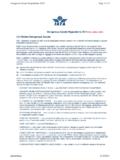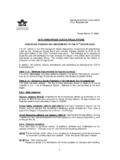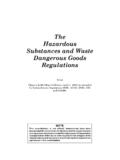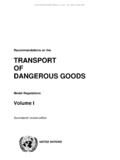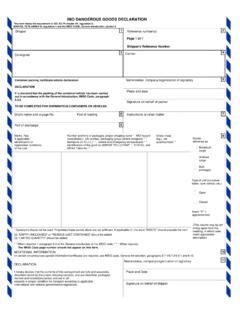Transcription of Conveyance of Dangerous Goods by Road (Part V1) …
1 Conveyance of Dangerous Goods by Road (Part V1) -LegislationNational Road Traffic Act, Act 93 of 1996; Chapter VIIIThe National Road Traffic Act, Act 93 of 1996makes it an offence for Dangerous Goods to be consigned, transported or received, except as prescribed in Chapter VIII of the National Road Traffic Regulations (Regulations 273 - 283B).National Road Traffic Act, 1996 iChapter VIII: Dangerous goods54. Transportation of certain Dangerous Goods prohibitedNo person shall, except as prescribed, offer for transportation in a vehicle, or transport in a vehicle, or accept after transportation in, on or by a vehicle, any prescribed Dangerous Appointment of Dangerous Goods inspector or inspectorate(1)(a)The Minister may appoint a person, an authority or a body as a Dangerous Goods inspector or inspectorate.
2 (b)The training and qualifications of a person appointed under paragraph (a) shall be as prescribed, and an authority or body shall have the services of persons with the prescribed training and qualifications at its disposal before that authority or body is so appointed.(2)The powers and duties of the inspector or inspectorate contemplated in subsection (1) (a) in relation to the transportation of prescribed Dangerous Goods shall be as prescribed.(3)The Minister may, in order to defray the expenditure incurred by or on behalf of that inspector or inspectorate for the purposes of performing his/ her or its functions, prescribe fees to be paid in respect of inspections carried out by him, her or it in terms of this Road Traffic Act, Act 93 of 1996: Regulations 273 - 283B273.
3 DefinitionsFor the purposes of this Chapter - competent authority means the competent authority listed in supplement 1 of the code of practice SANS 10229 Packaging of Dangerous Goods for road and rail transportation in South Africa ; consignor means the person who offers Dangerous Goods for transport in a vehicle referred to in Regulation 274 (1), and includesthe manufacturer or his or her agent, duly appointed as such; consignee means the person who accepts Dangerous Goods which have been transported in a vehicle referred to in Regulation 274 (1); Dangerous Goods inspector means a person appointed as such under section 55 of the Act; emergency action response system means a system designed to enable emergency crews arriving on the scene of an incident to determine, from coded placarding on the vehicle, or failing that, from the Tremcard or Dangerous Goods declaration, the identity of the cargo carried, the nature of the hazard presented and the emergency action to be taken to neutralize the danger, and is as prescribed in codes of practice: SANS 10232-1 Transportation of Dangerous Goods - Emergency information systems , Part 1: Emergency information system for road transportation ; and SANS 10232-3 Transportation of Dangerous Goods -Emergency information systems , Part 3: Emergency action codes.
4 "exempt quantities means those quantities that are exempt in accordance with code of practice SANS 10232-1 Transportation of Dangerous Goods Emergency information systems ; incident means an unplanned event during the transportation or storage of Dangerous Goods which involves leakage or spillage of Dangerous Goods or risk thereof; multiload means more than one type or hazard class of Dangerous Goods or substances carried together; (changed to MIXED LOAD via SANS : 2007, Edition 3, February 2007) premises means land or any building or other structure and includes any train, boat, ship, aircraft or other vehicle; qualified person means a person trained to perform any specific task, nominated by the operator, consignor or consignee under Regulation 277; and Tremcard means the transport emergency card listing the hazards and emergency information for a material being transported for use by the driver during an incident, or by the emergency services, if Incorporation of standardsSANS 1518 -Edition 3 -Transport of Dangerous Goods -Design, construction, testing, approval and maintenance of Road vehicles and Portable Tanks (This standard replaced SANS 11398 - Road tank vehicles for petroleum based flammable liquids.)
5 And SANS 11518 - Transportation of Dangerous Goods - design requirements for road tankers - February 2008)Codes of Practiceincorporated into these regulations by notice published by the chief executive officer in the Government Gazette:SANS 10228 - The identification and classification of Dangerous substances andgoodsSANS 10229 - Packaging of Dangerous Goods for road and rail transportation in South AfricaSANS 10230 - Transportation of Dangerous Goods - Inspection requirements for road vehiclesSANS 10231 -Transportation of Dangerous Goods -Operational requirements for road vehiclesSANS 10232-1 -Transportation of Dangerous Goods -Emergency information systems; Part 1: Emergency information system for road transportationSANS 10232-3 -Transportation of Dangerous Goods -Emergency information systems; Part 3: Emergency action codesSANS 10233 - Intermediate bulk containers for Dangerous substances274.
6 Application(1) Subject to sub regulation (2), this Chapter applies to all vehicles registered in the Republic, wherever they may be, and to all vehicles otherthan those registered in the Republic, whenever they are within the Republic, in or on which Dangerous Goods are transported, and to such Dangerous Goods .(2) These regulations do not apply in respect of Dangerous Goods which are transported in quantitieswhich do not exceed the exempt Other legislation applicableIf a provision in this Chapter is in conflict with a provision of the Explosives Act, 1956 (Act No 26 of 1956), the Nuclear Energy Act, 1993 (Act No 131 of 1993), the Fire Brigade Services Act, 1987 (Act No 99 of 1987), the Mines and Works Act, 1956 (Act No 27 of 1956), the Environment Conservation Act, 1989 (Act No 73 of 1989), the Occupational Health and Safety Act, 1993 (Act No 85 of 1993), the Hazardous Substances Act, 1973 (Act No 15 of 1973)
7 , or the Fertilizer, Farm Feeds, Agricultural Remedies and Stock Remedies Act, 1947 (Act No 36 of 1947), the latter provision shall take Transportation of Dangerous Goods prohibitedNo person shall operate on a public road any vehicle in or on which Dangerous Goods is transported, unless such Dangerous Goods is transported in accordance with this Chapter: Provided that -(a) Dangerous Goods which is required under this Chapter to be transported in a vehicle in respect of which standard specification SANS 11518 Transportation of Dangerous Goods - design requirements for road tankers , apply -(i) may be transported in such a vehicle; and(ii) shall be so transported in accordance with the said appropriate standard specification if the vehicle in which the said Dangerous Goods is being transported was registered for the first time on and after 1 October 2001; and (b) vehicles carrying Dangerous Goods in respect of which a placard is required to be fitted to such vehicle, maybe fitted with, but shall after 1 October 2001 be fitted, with the appropriate placards prescribed in code of practice SANS 10232-1 Transportation of Dangerous Goods Emergency information systems , Part 1: Emergency information system for road transportation.
8 276. Exemptions(1) The Minister may, after consultation with the competent authority concerned, either generally or subject to such conditions as he or she may deem fit, by way of notice in the Gazette, grant exemption in respect of a specific consignment of Dangerous Goods to be transported by any vehicle, or class or description of vehicle, from any of or all the provisions of this Chapter, and may, subject to giving reasonable notice, amend or cancel any exemption so granted.(2) The Dangerous Goods listed in code of practice SANS 10232-1 Transportation of Dangerous Goods - Emergency information systems are exempt from the provisions of these Regulations with regard to quantity or in its entirety, or the quantities of a multiload as determined by the factor, as indicated in that Code of Practice, and for the purpose of the Act, one litre of a substance, is equal to one kilogram of a in terms of SANS Exemptions from the requirements of this standard shall apply to the transport of Dangerous Goods when.
9 A) Goods being transported are used for the operation of the vehicle carrying them, for an example fuel in the fuel tank of a ) The Goods are moved between adjacent premises not more than 1 km ) Vehicles have built-in road construction machinery. d) The carriage of Dangerous Goods is undertaken by private individuals where the Goods are packaged for retail sale and are intended for individuals personal or domestic use or for their leisure or sporting ) The carriage is undertaken under the supervision of the emergency services, in particular by breakdown vehicles towing vehicles containing Dangerous Goods which have been involved in accidents or that have broken ) The emergency transport of Dangerous Goods is intended to save human lives or for the protection of the environment, provided that all necessary precautions are taken for the transport of such Goods in complete )
10 The Dangerous Goods are exempt from road transport regulations by special provision in SANS 10228 or in terms of table , andh) The Goods are transported by a bona fide farmer or an employee of the farmer and are intended for use in farming operations, provided that 1) The Goods are not used for resale either in their original form or in combination with any other substance,2) The journey does not exceed 250 km of which no more than 50 km shall be on a main arterial road designated with a N number,3) The quantity of classified Dangerous Goods in liquid form does not 1000 L,4) The quantity of classified Dangerous Goods in solid form does not 1000 kg, and5) The quantity of classified Dangerous Goods transported in a mixed load containing Goods in both liquid and solid form, in kilograms and litres, does not exceed Duties of operator, driver, consignor and consignee(1) The operator, driver, consignor and consignee shall, subject to any provision to the contrary contained in this Chapter, comply with the requirements with respect to the transportation of Dangerous Goods in or on a vehicle on a public road, as determined in the standard specifications and codes of practice referred to in Regulation 273A.

